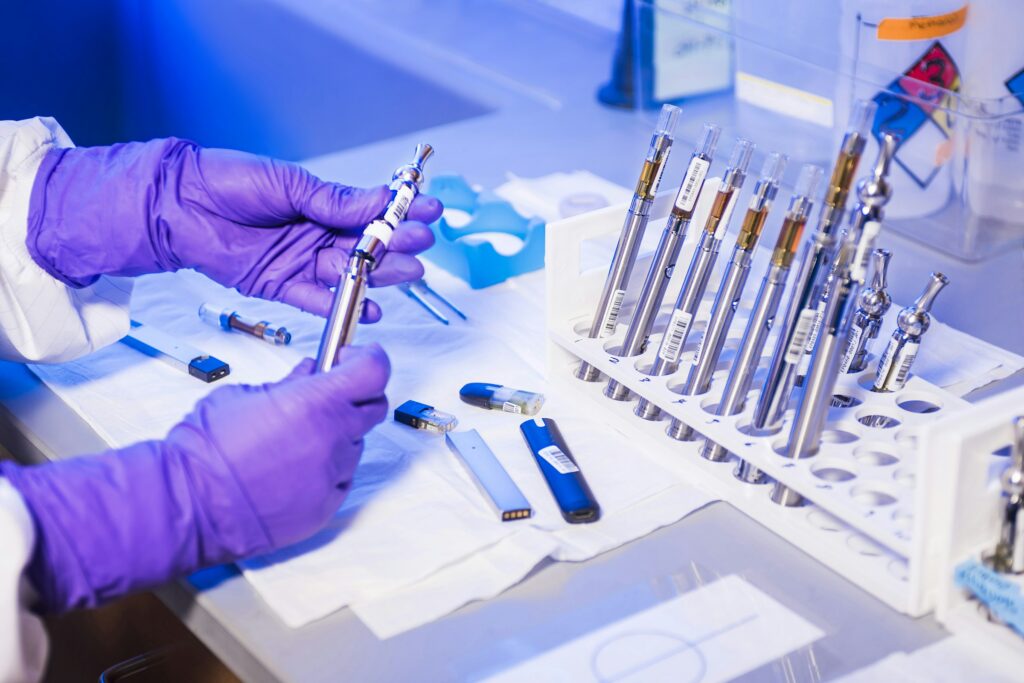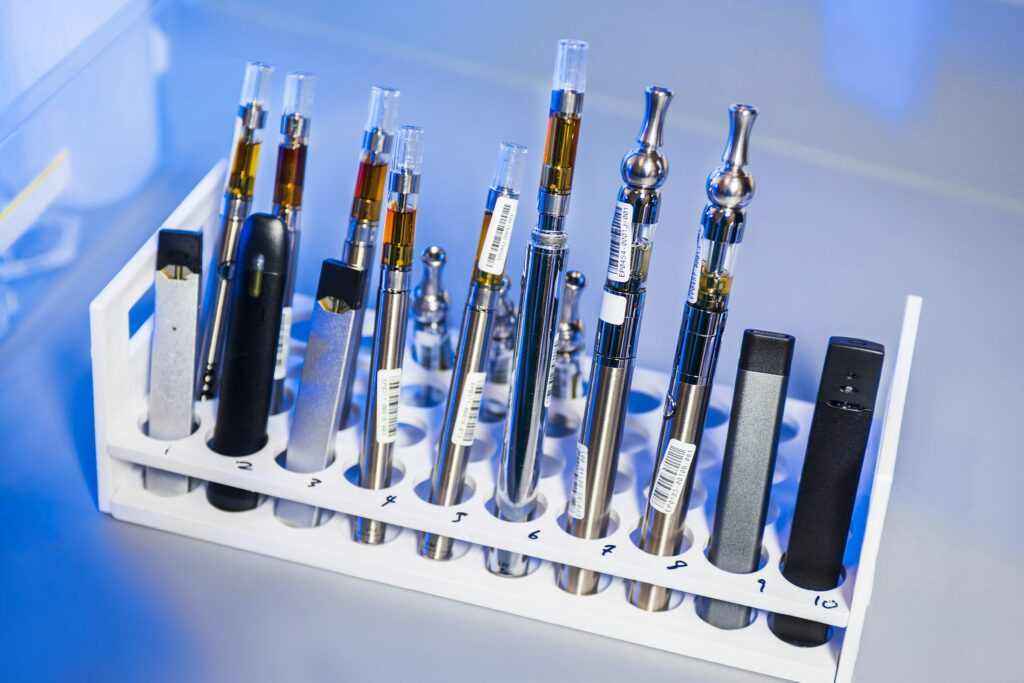Evidence-based Action on Vaping and Tobacco
Report from the Victorian Parliament’s 2024 Inquiry into Vaping and Tobacco Controls
By Bill Bainbridge
Senior Communications Adviser, Parliament of Victoria.
There is now a significant (and growing) body of evidence that relates to the health effects of vaping. Vapes, or e-cigarettes, vary widely in the chemical cocktail they contain.1 While the presence of nicotine (at wide-ranging levels) is a major health concern, its absence from a vape by no means removes the risk – and 60% of vape liquids labelled as “nicotine-free” were found to contain nicotine.1,2
Evidence provided to the Victorian Parliament’s recent Inquiry into Vaping and Tobacco Controls found a “wide range of substances and heavy chemicals … in e‑cigarettes, that are poisonous if inhaled including chemicals found in car batteries, disinfectants, fuel products and poisons”.3
The Public Accounts and Estimates Committee received 115 submissions, and heard from a wide range of experts in public health.4

Significant impacts on individuals and communities
Tobacco smoking is the leading preventable cause of death and disease in Victoria, and a key driver of social inequalities in health.2 Every year smoking costs the Victorian community 4,000 lives and $5 billion.5
The Committee found that tobacco use has declined in Victoria over the last 20 years.6 However there has been a rapid growth in vaping since 2018, particularly by young people including children.7
“We know now that one in three young people across Australia have vaped. We have gone from 3% of 18-year-olds or older vaping in 2018 to almost 18% by 2022, and we know that young people who vape are three times more likely to go on to smoke cigarettes,” Dr Sandro Demaio, the CEO of VicHealth told the inquiry.
Additionally, he notes that the unregulated nature of the market means many vapes contain dangerous substances.
“We know that e-cigarettes contain more than 200 toxic chemicals,” Dr Demaio said. “This plume is breathed deep into the lungs and into the lung tissue of increasing numbers of young people.”
Those chemicals include acetonitrile (found in car exhaust fumes), cadmium (found in batteries), benzene (found in petrol), chlorine (found in bleach), glyoxal (found in disinfectant), xylene (found in paint stripper), arsenic (found in rat poison) and many others. One 2019 study published by the Commonwealth Department of Health identified some 243 chemicals in total.1,8
Many submissions to the Committee claimed that e‑cigarette use is healthier than smoking cigarettes, but the evidence provided to the Committee did not support that conclusion.

Evidence-based policy required
Stricter regulation at the state and federal level is likely to reduce the number of illicit vapes available and therefore the number of toxic chemicals present in vapes. But e-cigarettes containing nicotine may still pose a health risk.
Dr William Cross of the Goulburn Valley Public Health Unit told the Committee that the “consumption of no nicotine is always preferable” but he added that better regulating products would be better than the current environment.
“We would also consider that regulated products are likely to be less harmful than unregulated products, as the latter can give an undisclosed amount of nicotine and may also contain a broader range of potentially harmful chemicals,” he said.
Nonetheless, the Committee heard that regardless of the presence of other harmful chemicals, nicotine is inherently addictive, and can increase the risk of serious health conditions.
Even the tobacco companies that appeared before the Committee agreed “the science is clearly established that nicotine is addictive”, with British American Tobacco Australia telling the Committee its position is that “if you do not use these products, do not start”.9
One submission to the inquiry from alcohol and drug consultancy 360Edge pointed out that, unlike other nicotine replacement therapies such as lozenges or nasal sprays, nicotine delivered via a vape can reach the brain in just 20 seconds.10
Some single disposable e-cigarettes for sale in Australia at the moment contain as much nicotine as 20 packets of cigarettes.11
VicHealth’s Dr Sandro Demaio told the Committee that addiction has an enormous impact on the social, educational and interpersonal development of young people.
“It also influences the developing brain and particularly the frontal lobe, which is responsible for decision-making and higher order thinking,” he said.
Victoria’s Chief Health Officer, Dr Clare Looker, told the Committee that research on the health impacts of e-cigarettes is still an evolving area but a number of health effects are already established.
“We know there is conclusive evidence that the use of e-cigarettes can cause E‑cigarette or Vaping‑Associated Lung Injury, or EVALI. There is also conclusive evidence about the risks of acute nicotine toxicity, including, as we know, a number of tragic deaths in young children who have accidentally consumed liquid nicotine,” she told the Committee.
“There is also conclusive evidence of burn injuries from exploding batteries. There is emerging evidence of links between e-cigarettes and cardiovascular impacts, impaired lung function, low birth weight in babies of women who have smoked during pregnancy and links between carcinogens found in many e-cigarettes and cancer.”
The Committee’s final report was tabled in the Legislative Assembly in August and makes 27 recommendations across a range of policy areas that aim to reduce the significant harms of tobacco and the emerging harms of e cigarettes.3

The government, which has already flagged its intention to introduce new legislation this year to better regulate e-cigarettes, has until February to respond to the report.
References:
- Banks, E., et al. (2022). Electronic cigarettes and health outcomes: systematic review of global evidence. Report for the Australian Department of Health. National Centre for Epidemiology and Population Health, ANU, Canberra. https://www.nhmrc.gov.au/sites/default/files/documents/attachments/ecigarettes/Electronic_cigarettes_and_health_outcomes_%20systematic_review_of_evidence.pdf
- Chivers, E., et al. (2019). Nicotine and Other Potentially Harmful Compounds in “nicotine‐free” E‐cigarette Liquids in Australia. Medical Journal of Australia, 210(3), 127–128. https://doi.org/10.5694/mja2.12059
- Inquiry into vaping and tobacco control. (2024). Parliament of Victoria. https://www.parliament.vic.gov.au/vapetobaccoinquiry
- Department of Health Victoria. (2024). Victorian public health and wellbeing plan 2023–27. DH. https://www.health.vic.gov.au/victorian-public-health-and-wellbeing-plan-2023-27
- VicHealth. (2019). Preventing tobacco use. VicHealth. https://www.vichealth.vic.gov.au/our-health/preventing-tobacco-use
- Australian Bureau of Statistics. (2023, December 15). National Health Survey, 2022, Table 29 (1.1, 1.3). ABS. https://www.abs.gov.au/statistics/health/health-conditions-and-risks/national-health-survey/latest-release
- Australian Institute of Health and Welfare. (2022). National Drug Strategy Household Survey 2022. Electronic cigarettes and vapes, Tables 3.3 and 3.4. Australian Institute of Health and Welfare. https://www.aihw.gov.au/about-our-data/our-data-collections/national-drug-strategy-household-survey/2022-ndshs
- National Industrial Chemicals Notification and Assessment Scheme (NICNAS). (2019). Non-nicotine liquids for e-cigarette devices in Australia: chemistry and health concerns. https://www.industrialchemicals.gov.au/sites/default/files/2020-08/Non-nicotine%20liquids%20for%20e-cigarette%20devices%20in%20Australia%20chemistry%20and%20health%20concerns%20%5BPDF%201.21%20MB%5D.pdf
- British American Tobacco Australia, public hearing, Melbourne, 15 July 2024, Transcript of evidence, p. 7
- 360Edge, Supplementary submission 72a, p. 12
- Prochaska, J. J., et al. (2021). Nicotine delivery and cigarette equivalents from vaping a JUULpod. Tobacco Control, 31(1). https://doi.org/10.1136/tobaccocontrol-2020-056367






